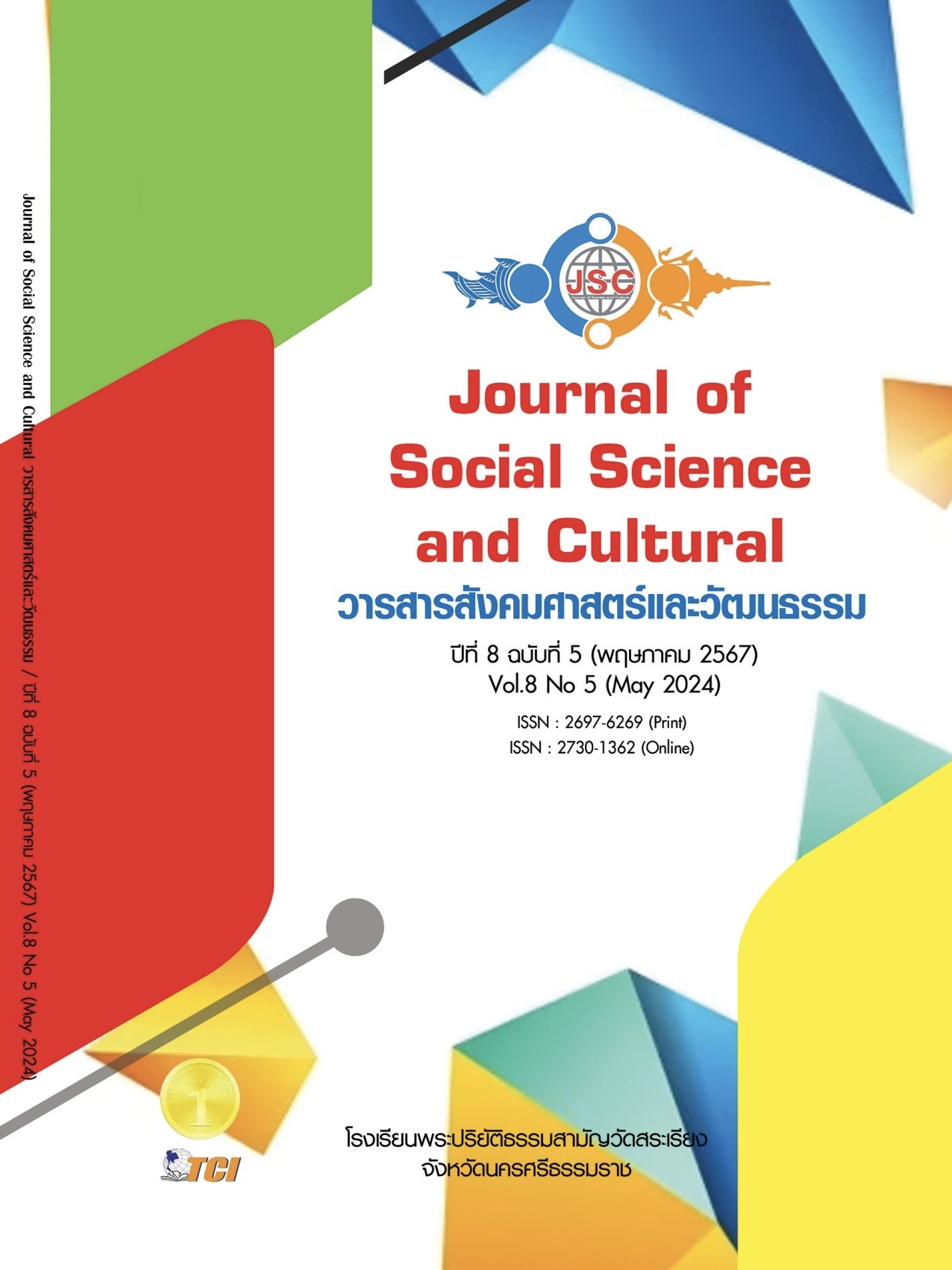DEVELOPMENT OF DIGITAL TECHNOLOGY MANAGEMENT MODEL WITH ACTIVE LEARNING TO ENHANCE CREATIVE THINKING OF UNDERGRADUATE STUDENTS
Main Article Content
Abstract
The purposes of this research were 1) Development of Digital technology Management Model with Active Learning and 2) to study the results of using Digital technology Management Model with Active Learning to Enhance Creative Thinking of Undergraduate Student. It is Research and development. The sample consisted of undergraduate students. Educational Technology and Communication Faculty of Education Naresuan University who is registered to study the course of Art and Graphic Design, Semester 2, Academic Year 2022, which was obtained by means of purposive sampling, numbering 25 people. The research tools included the Lesson Plan, Test of Creativity Thinking, and satisfaction questionnaire. Statistics used in the research are mean, standard deviation and t-test dependent. The results of the research found that 1) the developed model has 6 elements, including 1.1) objectives 1.2) content 1.3) active learning activities
1.4) digital technology 1.5) roles of learners and teachers and 1.6) Measurement and evaluation And there are 3 steps in the teaching model: Step 1, preparation step, step 2, learning activity step, consisting of 6 sub-steps as follows: introduction into the lesson, defining problems or goals, study and research, brainstorm, create work, present work and step 3, summary step, and
2) Students who studied with the digital technology management model combined with active learning had significantly higher creativity scores after studying than before studying at the 0.5 level, and students were satisfied with learning with this model. Overall, it is at a high level
( = 4.37, S.D. = 0.68).
Article Details
References
เจนจิรา เงินจันทร์. (2561). การประยุกต์ใช้เทคโนโลยีต่อการจัดการเรียนการสอนแบบ Active Learning ในศตวรรษที่ 21. วารสารการจัดการความรู้ มหาวิทยาลัยราชภัฏนครสวรรค์, 2561(1), 17-22.
นิพาดา ไตรรัตน์. (2563). การพัฒนารูปแบบการจัดกิจกรรมการเรียนรู้เชิงรุกบนเครือข่ายสังคมออนไลน์ เพื่อส่งเสริมความคิดสร้างสรรค์ของผู้เรียนระดับอุดมศึกษา. วารสารวิชาการศึกษาศาสตร์, 21(2), 130-142.
เนาวนิตย์ สงคราม. (2555). การพัฒนารูปแบบการเรียนการสอนแบบผสมผสานด้วยการเรียนรู้เชิงรุกเพื่อการสร้างองค์ความรู้และความสามารถในการแก้ปัญหาเชิงสร้างสรรค์ สำหรับนิสิตนักศึกษาครุศาสตรบัณฑิตในสถาบันอุดมศึกษาของรัฐ ทุนอุดหนุนงบประมาณแผ่นดิน. กรุงเทพมหานคร: จุฬาลงกรณ์มหาวิทยาลัย.
บุญชม ศรีสะอาด. (2553). การวิจัยสำหรับครู. (พิมพ์ครั้งที่ 3). กรุงเทพมหานคร: สุวีริยาสาสน์.
ประภัสสร เพชรสุ่ม. (2558). กระบวนการคิดวิเคราะห์เพื่อการเรียนรู้อย่างยั่งยืน. เรียกใช้เมื่อ 18 สิงหาคม 2564 จาก https://prapatsorn32.wordpress.com/2015/05/13/กระบวนการคิดวิเคราะห์เ/
วนาลี วรรณสิน และคณะ. (2564). ผลการจัดกิจกรรมการเรียนรู้เชิงรุกโดยใช้ปัญหาเป็นฐานผ่านเทคโนโลยีคลาวด์คอมพิวติ้งเพื่อเสริมสร้างทักษะวิถีแห่งการคิดเศรษฐกิจพอเพียงของนักเรียนชั้นมัธยมศึกษาปีที่ 6. วารสารวิชาการศึกษาศาสตร์ ศรีนครินทรวิโรฒ, 22(2), 132-151.
สำนักงานส่งเสริมสังคมแห่งการเรียนรู้และคุณภาพเยาวชน. (2558). สสค.ร่วมพัฒนาทักษะความคิดของเด็กและเยาวชน. เรียกใช้เมื่อ 18 สิงหาคม 2564 จาก https://www.thaihealth.or.th/สสค-ร่วมพัฒนาทักษะความค/
สุนทร พลเรือง. (2563). การพัฒนาการจัดกิจกรรมการเรียนรู้แบบเชิงรุกวิชาเคมี เรื่อง ปริมาณสัมพันธ์โดยใช้สื่อสังคมออนไลน์ Facebook และ Google Classroom ควบคู่กับการสอนปกติ. คุรุสภาวิทยาจารย์, 1(2), 97-106.
อัญญาณี สุมน และอุทิศ บำรุงชีพ. (2561). วิถีแห่งการคิดทางคณิตศาสตร์โดยประยุกต์ใช้เทคโนโลยีดิจิทัลเพื่อการเรียนรู้เชิงรุกสำหรับการศึกษาไทย 4.0. วารสารการศึกษาและการพัฒนาสังคม, 13(2), 14-29.
อารี พันธ์มณี. (2545). ฝึกให้คิดเป็น คิดให้สร้างสรรค์. กรุงเทพมหานคร: ใยไหม.
Bonwell, C. C. & Eison, J. A. (1991). Active Learning: Creating Excitement in the Classroom. ASHE-ERIC Higher Education Report No. 1. Washington, D.C.: The George Washington University, School of Education and Human Development.
Guilford, J. P. (1967). The Nature of Human Intelligence. New York: McGraw-Hill Book Co.
Joyce, B. & Weil, M. (1996). Models of Teaching. (5thed.). NeedhamHeights, MA: Allyn and Bacon.
Tracey, M. W. & Richey. R. C. (2007). ID Model Construction and Validation: A Multiple Intelligences Case. Educational Technology Research and Development, 55(4), 369-3900.


